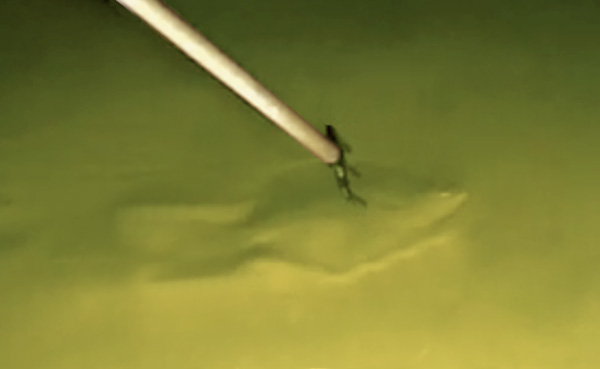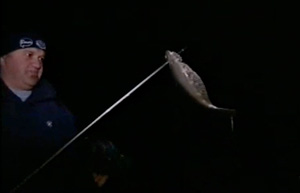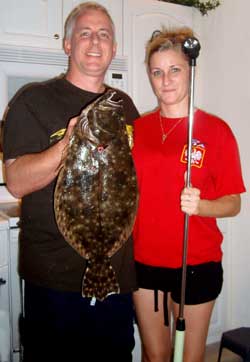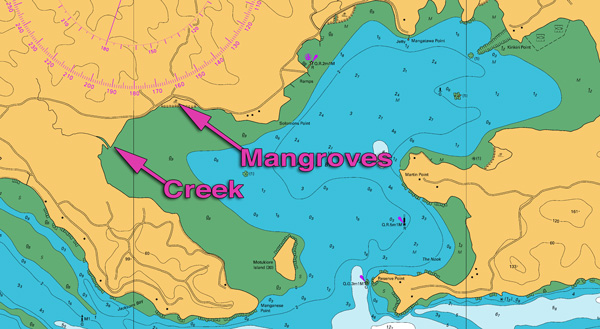Facts About Flounder
Spearing or gigging is a very enjoyable and productive way of flounder fishing, all you need is a good flounder light and a spear. In order to find top flounder fishing spots it's a good idea to learn about flounder seasonal migration patterns and preferred habitat.
In most areas of the USA, Australia and New Zealand flounder are most prolific inshore over the summer months.
Because of the warmer water, summer is the most popular time for gigging from flounder boats and wading using flounder gigs or spears and underwater fishing lights or lanterns.
The flounder come into very shallow water - sometimes only inches deep - after sunset.
Night fishing in the summer flounder season with an underwater light and spear or gig is very simple and productive.
When the light is shone on the flounder they stay very still and make an easy target.
Flounder Lights For Sale
In the USA winter flounder (also known as blackback) are the exception to the seasonal rule and they come into shallower waters during the winter months.
Flounder Fishing in New Zealand
Night flounder fishing in New Zealand and Australia is most popular over summer - gigging and spearing is popular and productive from November through to May, with the best months being January to April. However good flounder catches can be taken year round by spearing and gigging in the shallows.

Above: Another big flounder about to be gigged with the aid of powerful flounder lights
Setting flounder nets in channels is also a popular flounder fishing method in New Zealand and good catches can be taken year round.
More Flounder Facts
Flounder reproduction occurs offshore in late winter and spring when the fish spawn in water 25 to 35 metres deep.

Above: A nice yellowbelly flounder gigged at Kawhia Harbour |
Flounder fish biology is very unusual. All flatfish hatch offshore as a normal looking fish that swims vertically in the water column. The fingerling flounder gulp randomly for plankton until they are between 5 to 10mm long.
One of the most interesting characteristics in a flounder is during the larval stage when the left eye migrates around to the right side of the fish. This process takes around six to ten weeks and when complete the baby flounder settle on the bottom as a recognisable flatfish.
Once baby flounder settle on the bottom they move into very shallow inshore estuaries and the upper reaches of harbours.
What Do Flounders Eat?
The answer to what do flounder eat depends on the habitat in the area the fish are living.
Baby flatfish begin feeding as an ambush predator as soon as they settle on the bottom. The juvenile fish are normally in very shallow estuarine areas and feed on tiny shrimp like copepods, small crabs, a variety of sea worms and invertebrates.
Flounder Fishing Tips - Where To Flounder Gig
On exposed high energy west coast beaches in New Zealand big yellowbelly flounder often feed on worm beds in the inter tidal zone.
These beds can be located by driving along the beach at dead low tide while looking for differences in the texture of the sand.
A mottled, bubbly or matt texture are the signs to look for, have a dig in the spot and if you find small worms you are in business.
If you find a large worm bed take a good landmark and come back at night with a good flounder light and a gig and you will be amazed how easy it is to spear these fish as they come into water only inches deep to feast on the worms.
For the best catches of yellowbelly flounder make sure you are there before the incoming tide has covered the worm bed and when the surf is low.
If you have time also check out any areas where fresh water creeks enter the surf on the west coast.

Above: A big starry flounder taken gigging in Florida |
Here you will have a good chance of spearing New Zealand's biggest flounder species, the turbot. No one seems to know why flounder and turbot gather where the fresh water discharges into the sea on the west coast as these streams seem devoid of any prey, but I suspect it must be food related.
Turbot can weigh up to 5 pounds or more so it's well worth the effort even if you only get one or two.
To maximise your chances of catching west coast flounders, fish over a rising tide, and when the surf is low.
Incidentally flatfish taken from exposed west coast beaches are the best tasting flounder as there is no mud to taint the flesh.
On the east coast and in harbours and estuaries adult flounder eat
shrimp, copepods, small mud crabs, small shellfish, a variety of sea worms and invertebrates as well as small fish.
It is worth noting that flounder have been mentioned as a significant predator of whitebait.
On the east coast anywhere fresh water meets the sea has an abundant ecosystem of shrimp, crab and other small feed as well as whitebait when they return from the sea. Flounder congregate in the brackish zones to feed on the rising tide at night.
If you are trying to catch them with bait, flounder hooks should be kept as small as possible and if crabs are used peel the back shell off to allow the flounder to more easily gulp the bait.
Small shrimp taken from rock pools and yabbies are reportedly the best flounder baits. Garden worms or corn baits are often reported as good flounder bait but I doubt they would be better than flounders natural prey.
How Long Do Flounder Live
In New Zealand most flatfish are short lived and reach legal size around two years old, few survive more than five years. Female flounders live longer and reach a larger size than the males.
What Eats Flounder
All members of the flounder family are prolific breeders and they are very fast growing fish, this is because they have an extremely high mortality.
What fish eat the flounder depends upon how big the flounder is - so what fish prey on the flounder varies as flounder grow.
Juvenile flounder swim upright like every other fish and are preyed upon by everything big enough to eat them while they are midwater.
After they settle in the shallows, estuary flounder predators include seabirds such as shags, cormorants, gulls, eels, small kahawai, small sharks, gurnard, john dory, stingrays and small snapper.
As they grow flounders predators also include larger snapper, surprisingly some big snapper caught on the west coast have had nothing but adult flounder in their stomachs. Hammerhead sharks are also listed as one of flounders predators because they are able to detect completely buried flounder with the electro sensors located under their head.
Contact Us for more information about our flounder lights.
Flounder Info - Cleaning and Cooking
 Of all New Zealand's saltwater fish, flounder ranks high in both taste and texture. Of all New Zealand's saltwater fish, flounder ranks high in both taste and texture.
If you are going to buy flounder always look for bright full eyes and moist skin.
The two factors above are the two best indicators of how fresh the flounder is.
A lot of people who catch their own don't know what to do with flounder to keep it in top shape.
If you are fishing from a boat keep the fish on ice in a chilly bin or cooler.
Gutting flounder and removing the gills as soon as possible after catching increases the shelf life in the fridge and improves the taste.
Pan Fried Flounder Recipes
Cooking Flounder and Flatfish
Flounder fish cooking is simple if the fish are small. Just dry the fish, dust with flour and fry in a hot pan coated with half butter and half olive oil.
Season with salt and pepper to taste in the pan, or add seasonings to the flour. Cook until the skin crisps on the first side, then flip and cook the other side for the same length of time.
Where Do Flounders Live
While no one is likely to tell you, or publish their top floundering spots on the web for all to see, fortunately there are easily researched clues anyone can use to check out the general areas worth investigating.
Asking the locals personally - or at the local fishing tackle store - will sometimes also help point you in the right direction.
Do a search on Google web, or in your local fishing forums, for flounder fishing reports.
Below are highlighted several ways you can use the general information gleaned from the sources above to hone in on the hotspots for flounder fishing and gigging .
Go to Google maps and enter the general area, switch to sat view (satellite view) and if you are lucky Google will have a high resolution view of he area.
In New Zealand the main features to look for are creeks, mangroves, areas of flat rock, sea grass and blind channels.
Flounder Fishing Spots - Estuarine Creeks and Brackish Water
Finding the best flounder gigging or spearing spots is as simple as answering the questions, where do flounders live, what do flounder eat and where does it live?
Sources of freshwater intermingling with saltwater are the most sought after by feeding flounder. Brackish creeks are full of shrimp, copepods, crabs, whitebait and tiny shellfish - all of which are top prey for all flounder species.
A series of maps of the Mokau Estuary, which is a good spot for floundering are shown below. The first is a Google Sat view map of the creeks which empty into the main channel.
Note that as the creeks cross the beach the northern bank has less of a crazed pattern. This means the northern side has a firmer seabed than the southern side and is a good candidate for wading with a flounder gigging light and spearing the flatfish.
The softer the mud the more crazed it will become. If you zoom out on the map you will see why.
The catchments area drained by the creeks on the southern side of he estuary is much larger, hence more soft mud accumulates.
While I have walked the mudflat's on the northern side and found them quite firm, I personally wouldn't walk the southern side unless I had explored it thoroughly from the safety of a boat at all stages of the tide.
Gigging flounder from a boat in areas you are exploring is a lot safer than gigging on foot.
The boat allows access to areas inaccessible by road and also allows productive floundering areas where the mud is much too soft to wade through.
View Larger Map
Switching to the Google Ter view (Terrain) more clearly shows the catchments of creeks as they are drawn to show the entire creek system. Even if Google does not have a high resolution satellite image of the area the terrain view provides very useful information on flounder habitat.
View Larger Map
Where Do Flounder Live?
Another useful resource when learning how to catch flounders and finding where flounder live are marine charts. The one below shows one of my spots. The green areas show the intertidal zone. The flounder spend the day in the deeper water in the middle of this bay and come in with the tide at night. The best time to flounder gig in this area is from low to high tide with the last three hours of incoming tide being best.

I have gigged for flatfish here with our New Flounder Lights three times and have been successful twice. On the day we didn't catch any conditions seemed prefect, clear water, no wind and the water was warm, so like any fishing, floundering can be hit or miss.
Although not marked on the chart another two very small creeks discharge through the mangrove area and this is where we speared the best fish. As we waded at night we noticed that when you are approaching a small creek you first notice the water getting warmer and the mud softer, there are usually more mud crab holes and then you notice increasing numbers of small flounder. As you progress the best sized flounder are usually found laying in the softest mud.
The next best spots in this area was the marked creek and a shelf of flat rock outside the mangroves.

Above: Flounder are masters of camouflage and are very difficult to spot in the daytime. At night they stand out clearly and remain motionless if a bright flounder gigging light is shone on them.
It is worth noting that flounder seek out warm water. Intertidal sandstone (papa rock) is common in some harbours and estuaries, this rock holds the heat of the sun well into the night. It is very common for flounder to seek out these areas and sometimes a limit bag can be taken from a small area.
Below is the same marine chart as shown above zoomed on the best area. Marine charts denote the bottom type with M for mud bottoms, SM for soft mud, Sh for shell, R for Rock and S for sand.
Mud and soft mud are best for floundering on the east coast of New Zealand althought good catches are sometimes taken over sandy bottom types and eelgrass beds. Gigging very soft mud areas is best done from a boat.

The key to safe floundering is in thoroughly checking likely areas during the day by walking the entire area at low tide.
Take a note of areas of very soft mud or deep channels that can cut you off on the incoming tide.
Also keep a lookout for promising areas of creeks, abundant crab holes or shrimp and flat rocks as these are the areas you find the best fish.
NZ Commercial Flounder Fishery
Hauraki gulf flounder tend to prefer the Thames Estuary and most of the east coast commercial catch comes from there.
On the west coast the expansive tidal areas of the Kaipara Harbour is also noted for it's flatfish fishery - although conflict between commercial and non-commercial fishers has been reported frequently over the last 30 years.
Most of the conflict is because commercial fishers are able to fish anywhere in the areas they have quota for and their flat bottomed flounder boats are small enough to fit on a trailer so the commercial fleet is very mobile.
Commercial fishers have been given so much annual quota they have not been able to catch it in any year over the last 23 years so the commercial catch is not constrained by quota.
Flounder are found throughout New Zealand and most harbours and estuaries have a few commercial fishers operating at different times, usually an area is fished out before the commercial fishers move to the next harbour or estuary and this is the main cause of the conflict between commercial and non-commercial fishers.
Flounder Regulations
The NZ flounder regulations cover both netting and gigging (spearing) of the 13 flounder species found in New Zealand. The flounder gigging regulations include size limits and bag limits.
Netting regulations are more detailed and include maximum net lengths and minimum mesh sizes as well as closed areas.
For more information on the flounder fishing regulations and flounder limits in NZ check out the Ministry of Fisheries official website, you need to select your area.
Flounder Information From MFish and Set Net Regulations
More Flounder Info
Contact Us for more information about our flounder lights. |
|